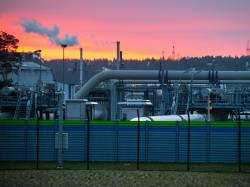With every escalation on the border with Ukraine, the likelihood of Nord Stream 2 going live decreases. This is manageable for Germany: the shutdown of the pipeline would at best mean higher gas prices. But Russia has much more to lose with Nord Stream 2.
First a meeting with US President Joe Biden, then with the Ukrainian President Volodymyr Zelenskyj: Chancellor Olaf Scholz does not take the words Nord and Stream and the number two into his mouth. For a long time, the SPD politician would not agree that an escalation on the Russian-Ukrainian border would mean the end of the Nord Stream 2 pipeline project – until he met the Russian president. Only after the one-to-one conversation with Vladimir Putin did Scholz allow himself to pronounce the name of the pipeline. Possibly because he wants to set an example. And because he knows how painful such a decision would be for Putin.
Because just as Germany has made itself dependent on Russian gas imports, Russia has made itself dependent on gas exports to Europe. The 1,230-kilometer Nord Stream 2 pipeline is expected to deliver 55 billion cubic meters of gas annually. For comparison: Germany consumed 86.5 billion cubic meters of gas in 2020. For the Germans, the pipeline, which has not yet been put into operation, would primarily lead to a price reduction – it is not necessary for gas supply. For Putin, it’s about much more than just the purchase prices.
The petroeconomics
In recent decades, the Russian economy has increasingly developed in the direction of a so-called petro-economy. Direct revenues from oil and gas accounted for around 12 percent of gross domestic product in 2019. More than half of the export economy consists of oil and gas. And it doesn’t stop there. Entire villages, industries and very high wages arise around the gas and oil production, which boost the economy.
Of course, dependence on gas and oil also has its downsides. Putin is trying to make his country increasingly independent of fossil fuels. Reserves have been built up in recent years to cushion the effects of oil and gas price fluctuations. The country now has foreign exchange reserves worth almost $600 billion, equivalent to 40 percent of GDP – far more than any EU country.
But Russia’s economy is still powered by fossil fuels. This is particularly noticeable in the coupling of the ruble oil price, “which is closely correlated,” says Georg Zachmann, an economist in the field of gas and electricity markets at the Brussels think tank Bruegel. When gas and oil prices rise, the value of the ruble increases – and vice versa, of course. When gas prices collapsed at the beginning of the pandemic, hardly any country felt it more than Russia.
So the Nord Stream 2 pipeline, with a capacity of 55 billion cubic meters per year, would be a dream come true for Putin and his gas-dependent economy. But at the same time, Putin is preventing the start of this pipeline with a possible escalation in Ukraine: “It is unlikely that Nord Stream 2 will be approved in the event of a war,” says Claudia Kemfert from the German Institute for Economic Research. “But Russia seems to have taken this into account.” Either Putin is just playing a big game of poker, or he has in fact already found alternative markets for the gas. In a world that is saying goodbye to coal, that’s not so far-fetched. Until net zero is reached, gas will become more and more in demand – and not only in Europe.
alternative markets
Gas consumption in China has increased massively since 2000. In 2019, the “Power of Siberia 1” pipeline was put into operation. It transports gas from Eastern Siberia to China. Transporting more gas east would be one way for Russia to compensate for the loss of Nord Stream 2. The problem: The amount is relatively manageable compared to what is exported to Europe. And in the short term, exports to the East cannot be increased either. Talks between Moscow and Beijing about further pipelines have already begun. But the leadership in China refuses to bear the costs of these projects.
Turkey could also offer an alternative market: surprisingly, in 2021 Putin exported much more gas to Ankara than before. That’s because Turkey has scaled back coal-fired power generation and ramped up gas-fired power plants. So while gas storage in Germany is at an all-time low, Russia is filling up storage in Turkey instead. “It’s amazing how much gas has flowed into Turkey,” says Zachmann. Mainly because of the current weakness of the Turkish economy.
But that won’t be economically worthwhile for Russia much longer. Because two aspects determine who pays how much for gas from Russia. “Countries that have alternatives get a lower price,” says Zachmann. And: “Countries that are friendly with Russia also get a discount.” His assumption: Russia sold more to Turkey, but got much less money for it than in Europe.
long-term thinking
No European country spends more money on Russian gas than Germany. A direct connection to Germany via Nord Stream 2 would secure Russian natural gas exports in the long term – and thus also long-term economic development.
On the other hand, the supply situation would not change much for Germany with or without the pipeline, because 90 percent of Russian natural gas from Nord Stream 2 is to flow to Eastern and Southern Europe. “It worked before without the pipeline, it will work afterwards without the pipeline,” says Zachmann.
